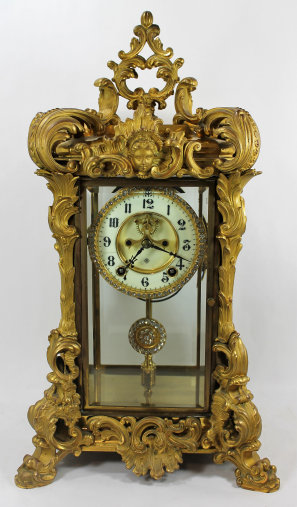

557. $425
Waterbury “Calendar No. 32”, ca. 1891. A 38-inch walnut case with railings along the top and
bottom on a double-dial calendar that differs from the catalog illustrations: Note that the pendulum shows through a window in-between
the two dials, rather than below the calendar dial as is typical for this model. We see no evidence that the clock has been
modified post-production. Both dials are newer paper, the lower dial is signed, and the calendar hand is a replacement; the
door glass is newer as well. The 8-day time-and-half-hour strike movement is unsigned and is running and striking; the calendar
is advancing. There is no label. The only sale in the Antique Clocks Price Guide was in 2012 for $1700; we sold one last
year for $627. This clock is not as common as you might think. $600-$1000.
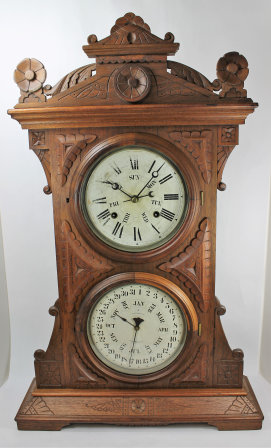
558. $1100
Welch, Spring & Co. “Audran, B.W.”, ca. 1872. This model is covered in carvings and ornaments
making it one of the prettiest calendar shelf clocks. There actually are two styles that differ in the type of ornamentation;
both can be seen on page 339 of Ly’s Calendar Clocks. The 31-inch walnut case has been refinished very nicely and is just fine
the way it is. Two very old paper dials, the calendar dial signed; five old hands and two old glasses. The 8-day time-and-strike
spring movement is unsigned but matches the one shown in Ly, with the club tooth escapement. It is running easily and the calendar
is advancing. The calendar movement bears a B.B. Lewis black label with the manufacturer (Welch, Spring & Co.) and instructions
setting the calendar. We sold a very similar example in Jan 2017 for $1660. $1200-$1600.
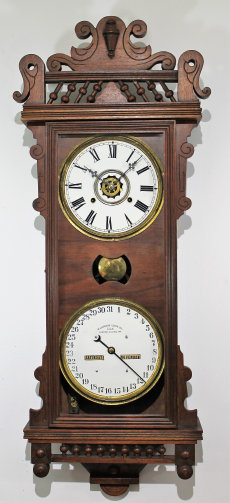
559. $1500
Seth Thomas “Office Calendar No. 3”, ca. 1863. Commonly called the “Peanut”, a highly sought-after
early calendar wall clock from Seth Thomas. This model had some unique characteristics: it used a round movement, time-only,
that had two small springs and ran 8 days. This is the only clock that used that movement; it also had ST trademark hands. The rosewood-veneered case is 24 inches tall with rosewood on the sides as well; the dials are painted and touched up; both were probably
repainted long ago, and the calendar rollers likely repapered as well. The clock is running nicely and the calendar is advancing. There is a label on the door and a door key is included. The last one we sold went for $3000 in Jan 2017. $1800-$3000.
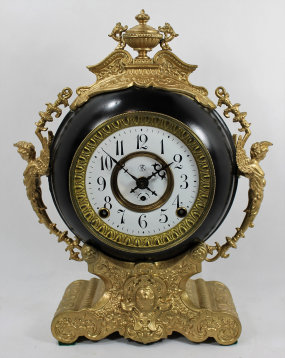
560. $125
Kroeber “India”, ca. 1895. This enameled iron clock is 14 inches high with a signed porcelain
dial and elaborate hands. There is a flat glass in the rococo sash. This model came in a number of colors and with a variety
of dial types. This one has been repainted and the gilded ornaments repainted as well. The small dolphin ornament on the
top right has been reglued into position. The unsigned 8-day time-and-strike movement is running and striking on the hours and
half-hours. Schmitt’s sold one in 2013 for $150. $125-$200.
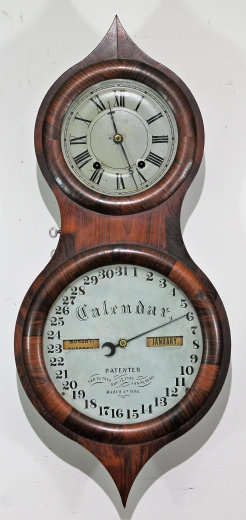
561. $375
Ansonia “La Nord”, ca. 1904. This 12-inch porcelain clock has great coloring and no flaws,
repairs, or loss of gold highlighting. The porcelain dial shows two hairlines between the 10 and 11. The Ansonia movement
is running, reluctantly, and needs some attention to get it running steadily. It may just need to be unwound to loosen up. Beveled glass in the sash. $375-$500.
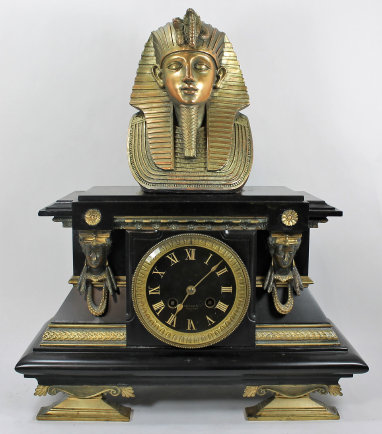
562. $500
Japy Freres Egyptian-themed black mantel, ca. 1925. The discovery of Tutankhamun’s unplundered
tomb in 1922 set off the Egyptian-art deco movement and led to impressive decorative items like this French clock, with a bust of
the King’s death mask. Note the vulture head and cobra on the headpiece, symbolizing rulership over upper and lower Egypt. The case is of black slate and weighs 36 lb, standing 16.5 inches tall. There is some brassing to the face of the figure, but
most of the brass ornaments and decorations are in excellent shape. The dial is marked “N Matson & Co, Chicago Ill”, a jeweler
that went out of business in 1887; the likelihood here is that this Japy Freres movement, made about 1879 (based on the medal stamp
on the movement) replaces the movement that came with this case. The case itself is not signed. There is a small piece
missing from the cornice at the right rear but it is not particularly noticeable. The clock is running and striking. Usually
you have to go to Los Angeles to find a clock like this. $500-$1500.
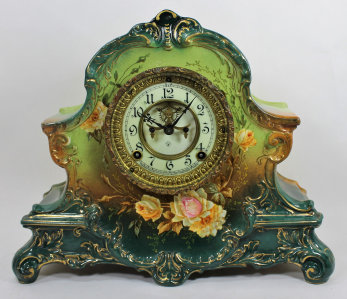
563. $250
Seth Thomas “Signet V.P.”, ca. 1880. A relatively short-lived clock from Seth Thomas (5 years)
with an unusual look for the time (see that pun?). The walnut-veneered case is 23 inches with burled walnut geometric designs
and ebony trim rings. The case is in rough shape, and a long strip of veneer is missing off the right side (see photo). Both glasses are old, the lower with the original paint and “Visible Pendulum”. The dial paint has been touched up and is probably
a very old repaint. Hands are original and rusty, as is much of the movement. This is the 8-day time-and-strike model,
with a wire gong (they also made a time-only model). It will run and strike briefly, but needs a thorough cleaning, as does
the case. The black label inside is faded to black and unreadable. We sold a beautiful example last summer for over $500,
but that one was exceptional. $260-$400.
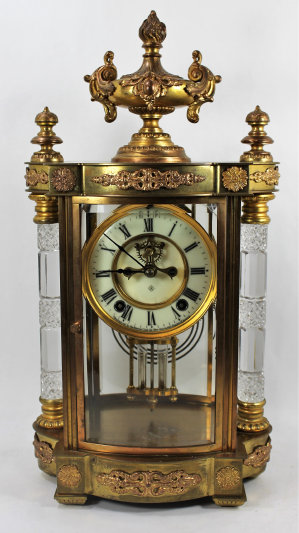
564. $900
Ansonia “Jupiter”, ca. 1914. One of Ansonia’s higher-end crystal regulators with cut glass
columns on either side, convex beveled glass doors, polished brass and rich gold ornaments. The brass could use some polish
here, but otherwise this clock is in fine shape. There is a crack across the front glass in the upper right corner and the very
left corner of the back door, but neither one is noticeable. There is some discoloration to the inside bottom, while the porcelain
dial with the Ansonia logo is flawless. The clock is running and striking. There are Chinese reproductions of this model
but they lack the “rack and snail” strike mechanism. Authentic Jupiters sell for $1500-$2000.

565. $1750
Ansonia “Apex”, ca. 1905. This is the deluxe version of the Apex, fitted with a jeweled sash
and pendulum. The Rich Gold finish is in good shape (although far from new) and all the trim pieces are present. The top
is not fastened down (it needs a nut underneath the top and is hard to get to without removing the movement), but that doesn’t matter
unless you plan to carry it around with you. There is a hairline crack in the porcelain outer dial between the 8 and 9. All beveled glasses are just about perfect – I see a bit of a chip in the upper right corner of the front door. The clock is
running easily but the strike needs adjustment as it only strikes once on the hour and half-hour. $2000-$2500.
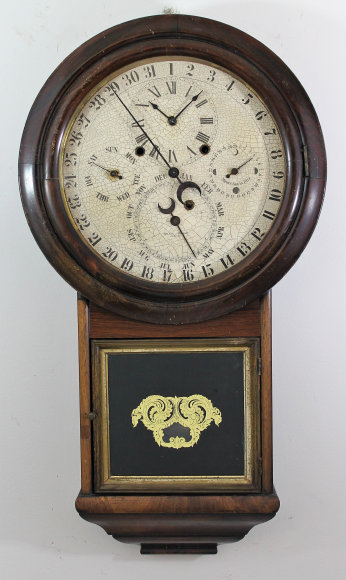
566. $1500
Welch, Spring & Co. “Gale Drop Calendar No. 2”, ca. 1880. There were at least three models
of this complicated clock made, as described starting on page 48 of Ly’s book Calendar Clocks. However, it appears that parts
were often mixed, either at the factory or in Bubba’s shop later on. This one contains an unsigned No. 2 movement and a repainted
dial that matches the movement (note the opening on the year dial to view the leap year indicator) but was painted to match the No.
1 dial shown in the 1880 catalog illustration (it lacks the sunrise and sunset times on the year dial). Why the paint is so
crackled is not clear to us; Ly says that No. 2’s and 3’s typically had paper dials that included sunrise and sunset times. The glass is a No. 1 design, looks original but has been rebacked. Even the pendulum bobs differed between models; this one
has a No. 1 bob. The faded label inside is appropriate to both Model 1 and 2. The calendar hands are correct but the time
hands are replacements. Incidentally, the dial tells you the time, date, day, month and – bonus – the moon’s monthly age in
days. Setting all these hands is complicated but is described in Ly’s book. The 28-inch case is rosewood veneer with grain-painted
bezels; the dial glass is old, the base may possibly be a very old replacement. The 8-day time-and-strike movement is running
vigorously, striking and keeping time, and the calendar hands are advancing. Your challenge will be to set them correctly. We sold a No. 2 in similar condition in 2014 for $2800, and a very nice No. 1 in 2017 for $3650. $2500-$3500.
